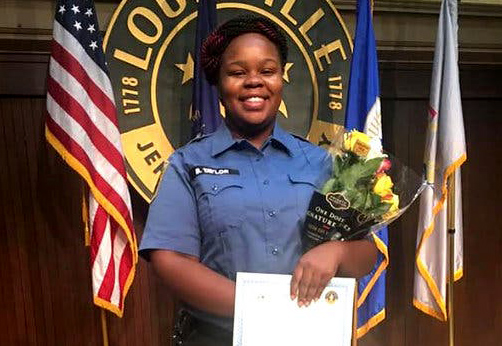
By Itané O. Coleman
On November 21, 2006, Kathryn Johnston was ninety-two. Police entered her home. They shot her six times. Killing her.[1]
On May 16, 2010, Aiyana Jones was seven. Police entered her grandmother’s home. They shot the child while sleeping. Killing her.[2]
Though Black men are often the face of police violence for a number of reasons, Black women and girls are susceptible to violence as well. Black women are only 13 percent of the female population, but account for 28 percent of unarmed deaths in the U.S.[3] The rise of campaigns, such as #SayHerName and #BlackLivesMatter, have attempted to curtail ignorance surrounding violence against Black women and girls, but their stories remain on the fringes of justice and accountability.
Since 2015, about 250 women have been fatally shot by the police in their homes or place of residence.[4] At least forty-eight of those women were Black,[5] and Breonna Taylor was one of them. The fatal events leading to her death are a viable starting point for noting the implications of a contributor to the unarmed deaths of Black women: no-knock warrants.
On March 13, 2020, plain-clothed police officers executed a no-knock search warrant, to enter Taylor’s Louisville, Kentucky, apartment.[6] Though the actual location officers were looking for was more than ten miles away from Taylor’s home,[7] they were under the belief that her apartment was being used for drugs. Taylor and Kenneth Walker, her boyfriend, were asleep when they heard banging at the door.[8] Fearing that their home was being burglarized, Walker grabbed a legal firearm and fired one shot in self-defense, injuring an officer.[9] The officers’ response to Walker’s warning shot manifested in the form of twenty-two rounds, eight of which fatally wounded Taylor.[10] No drug evidence was found[11] and the suspect the officers were looking for was in police custody at the time Taylor’s home was raided.[12]
As a result of these events, the Louisville Metro Council voted 26-0 in favor of Breonna’s Law, an ordinance that bans the enforcement of no-knock warrants. Louisville Metro Police Detective Joshua Haynes was also placed on administrative leave for executing the warrant that led to Taylor’s death,[13] but no officers have been charged for this unarmed killing. Many states have proposed bans on no-knock warrants as an attempt of policing reform. One victim of a no-knock raid gone wrong stated, “This is about race. You don’t see SWAT teams going into a white-collar community, throwing grenades into their homes.”[14] The 2013 death of Alberta Spruill as a result of police breaking into her apartment and setting off grenades is one of countless examples of Black lives being treated as criminal and disposable.[15]
According to David Alan Sklansky, a Professor of Criminal Law at Stanford, no-knock warrants disproportionately impact Black people and other people of color.[16] This policing tactic is a racialized product of the War on Drugs.[17] During the 1960s and 70s, no-knock warrants were disproportionately enforced in Black communities, reaffirming the perception that Blackness was synonymous with criminality.[18] In fact, no-knock warrants became so problematic that Congress repealed the statute authorizing their use due to reports of mistaken violent, and often illegal raids.[19] Despite the problematic nature of no-knock warrants, Supreme Court cases in the 1990s and early 2000s paved the way for their reemergence.[20]
In deciding the parameters of no-knock warrants, the Supreme Court ruled that the Fourth Amendment incorporates a knock-and-announce requirement.[21] In Wilson v. Arkansas,[22] the Court held that knock and announce is a factor in a reasonableness test of the Fourth Amendment, but not a requirement.[23] The Court did not specify instances that would make unannounced entries reasonable.[24] Instead, it delegated the task of determining the reasonableness of unannounced entries to state courts,[25] opening the door for unpredictable enforcement of no-knock warrants. In Richards v. Wisconsin,[26] the Supreme Court expanded the likelihood of unannounced entries by “explicitly approv[ing] of states giving magistrates the authority to issue no-knock warrants.”[27] Richards became the national standard for upholding searches conducted with no-knock warrants[28] because the Court imposed a reasonable suspicion standard that would allow officers to utilize discretion in announcing their presence.[29] The Court’s reasonableness standard “amounted to reasonable suspicion, meaning that a relatively low quantum of evidence was necessary for an action.”[30]
Though most states have a knock-and-announce statute on the books, state and federal courts often interpret exceptions to these statutes, such as the destruction of evidence and danger to police officers.[31] As a result of widespread judicial discretion regarding these warrants, they are routinely issued and are easier to get than most people would think.[32] Coincided with the rate of gun ownership in this country, no-knock warrants tend to result in violent and fatal outcomes.[33] As a result, public recognition of no-knock warrants as an aggressive and intrusive practice has grown. [34] Part of the problem is that no-knock warrants are often executed at night and fail to ensure the safety of civilians and officers.[35]
The death of Breonna Taylor is one of many examples of unarmed Black women impacted by no-knock warrants. Racialized police tactics require an understanding of the ways in which Black and Brown lives are balanced against police discretion. More often than not, the loss of Black and Brown lives do not outweigh implicit bias in U.S. policing. Though the path to racial injustice is long, 2020 has seen a heightened demand for learning and change. Thus, the death of Breonna Taylor should encourage interrogation of no-knock warrants and equitable reform.[36]
[1] Regina Jennings, From Slavery to Contemporary Genocide: A Literary and Linguistic Analysis of Why American Blacks Deserve Reparations, 18 Race, Gender, and Class 73, 75 (2011).
[2] 7-Year-Old Girl Accidentally Shot By Swat Team, ACLU, https://www.aclu.org/other/7-year-old-girl-accidentally-shot-swat-team (last visited October 22, 2020).
[3] Marisa Iati et al., Nearly 250 Women Have Been Fatally Shot by Police Since 2015, Wash. Post, (Sept. 4, 2020), https://www.washingtonpost.com/graphics/2020/investigations/police-shootings-women/.
[4] Id.
[5] Id.
[6] Aliss Higham, Breonna Taylor: Who Was Breonna Taylor? What Happened to Her?, Express, (June 5, 2020), https://www.express.co.uk/news/world/1291365/Breonna-Taylor-who-is-Breonna-Taylor-what-happened-black-lives-.
[7] Pilar Melendez, Louisville Cop Placed on Leave After Applying for Search Warrant in Breonna Taylor Case, Daily Beast, (June 10, 2020), https://www.thedailybeast.com/louisville-metro-police-detective-joshua-jaynes-placed-on-administrative-leave-in-breonna-taylor-case.
[8] Id.
[9] Id.
[10] Higham, supra note 6.
[11] David A. Sklansky & Sharon Driscoll, Stanford’s David Sklansky on the Breonna Taylor Case, No-Knock Warrants, and Reform, Stan. L. Sch., (Sept. 28, 2020), https://law.stanford.edu/2020/09/28/stanfords-david-sklansky-on-the-breonna-taylor-case-no-knock-warrants-and-reform/.
[12] Melendez, supra note 7.
[13] Melendez, supra note 7.
[14] Brian Dolan, To Knock or Not to Knock? No-Knock Warrants and Confrontational Policing, 93 St. John’s L. Rev. 201, 226 (2019).
[15] Jennings, supra note 1, at 75.
[16] Sklansky & Driscoll, supra note 11.
[17] Dolan, supra note 14, at 211.
[18] Carl Suddler, The Color of Justice Without Prejudice: Youth, Race, and Crime in the Case of the Harlem Six, 57 Am. Stud. 57, 58 (2018).
[19] Dolan, supra note 14, at 211.
[20] Id. at 212.
[21] Adina Schwartz, Homes as Folding Umbrellas: Two Supreme Court Decisions on “Knock and Announce,” 25 Am. J. Crim. L. 545, 546 (1998).
[22] 514 U.S. 927 (1995).
[23] Schwartz, supra note 21, at 550.
[24] Id.
[25] Id.
[26] 520 U.S. 385 (1997).
[27] Dolan, supra note 14, at 213.
[28] Id.
[29] See Richards, 520 U.S. at 394.
[30] David M. Jones, What Does “Knock And Announce” Mean? An Analysis of Wilson v. Arkansas and Its Progeny, 26 Am. J. Crim. Just. 287, 293 (2002).
[31] Dolan, supra note 14, at 214.
[32] See id. at 223–24.
[33] Id. at 220.
[34] Id. at 207.
[35] Id. at 216.
[36] Several cities, such as San Antonio, Texas, and Santa Fe, New Mexico, have followed Louisville’s lead in banning no-knock warrants. Ray Sanchez, Laws Ending No-Knock Warrants After Breonna Taylor’s Death Are A ‘Big Deal’ But Not Enough, CNN, (October 10, 2020, 6:03 AM), https://www.cnn.com/2020/10/10/us/no-knock-warrant-bans-breonna-taylor/index.html. Though most states allow no-knock warrants, Breonna’s Law has inspired a ban on the national level. Chantal Da Silva, Where Are No-Knock Warrants Legal? Bipartisan Bill Seeks Ban After Breonna Taylor’s Death, Newsweek., (June 12, 2020, 10:30 AM), https://www.newsweek.com/where-are-no-knock-warrants-legal-bipartisan-bill-seeks-ban-after-breonna-taylors-death-1510478. After speaking with Taylor’s family concerning the tragedy, Senator Rand Paul introduced a bill called the Justice for Breonna Taylor Act, which if passed, would end no-knock raids in the United States. Id.




